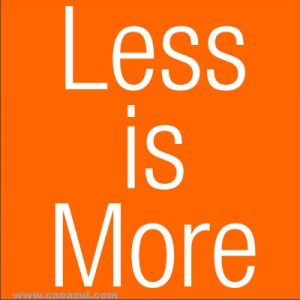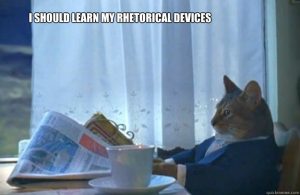This post is a continuation of my discussion of writing and the English language. Yesterday and Monday, I posted about oxymora and some tips about writing well. Both posts were based on handouts I used to give my students when I was teaching journalism at the University of Illinois. If you haven’t seen them, I urge you to take a look. Here is another handout I used to give my students. It deals with rhetorical devices and how to employ them in your writing. I hope you find it useful.
Style must be in harmony with content, and with the story’s purpose and audience. The best way—perhaps the only way to acquire a distinctive style is by reading and analyzing excellent writing. When this is done with care, you will begin to absorb into your language patterns, some useful techniques that will improve your writing.
Because style is a matter of emphasizing the essential parts of your subject—your facts or your feelings—remember that the most faithful servants of emphasis are surprise and variety. Too much surprise will exhaust readers, thus making them immune to it. But too much familiarity will bore them.
Though readers may be unaware of an article’s tone, remember that they are nevertheless affected by it, for tone is contagious. Therefore, take care to choose words that accurately convey your feelings about the subject at hand.
Finally, because laziness in word choice, staleness, and monotony are the enemies of style, a writer must occasionally let words cut unexpected capers. Writers must strive to remain unpredictable. If there is a secret of good writing, perhaps that is it.
A Glossary of Rhetorical Terms
Alliteration: The occurrence of words more or less in sequence having the same beginning sound. (“words that had warmed women, wooed and won them…”—Gay Telese).
Allusion: Reference to a well-known book, person, place, or event. Allusion is an economical way to enrich the impact of your writing with emotional and intellectual echoes from another work. (“If a [McDonald’s] manager tries to sell his customers hamburgers that have been off the grill more than 10 minutes…Big Brother in Oak Brook will find out.”—Time. Big Brother is a reference to the supreme authority in George Orwell’s 1984. “(The photograph) shocked the nation into realizing that something was rotten in Vietnam.”—John G. Morris. An allusion to Hamlet.
Anticlimax: A descent from a comparatively lofty vocabulary or tone to one noticeably less exalted. If the drop is sudden, the effect is often comic. (“Fun is for the frivolous, and Jimmy (Carter) sees the world as a hard and serious place. Man was put here to suffer, to atone, to repent, to confess, to surrender, to witness, or else to bake until well-did.” Larry L. King)
Antithesis: Figure of balance in which contrasting ideas are intentionally juxtaposed. (“The world will little note, nor long remember, what we say here, but it can never forget what they did here.” President Lincoln. “We are caught in war, wanting peace. We’re torn by division, wanting unity.” President Nixon.
Connotation: The implications or suggestions evoked by a word. Connotations may be highly individual, based on associations because of pleasant or unpleasant experiences in a person’s life, or universal—that is, culturally conditioned.
Denotation: The literal meaning of a word, exclusive of attitudes or feelings the writer or speaker may have.
Hyperbole: Exaggeration as a means of achieving emphasis, humor, and sometimes irony. (“Here she [Ann Miller] stands for a moment, examining legs that start at the waist and end nine miles below in a pair of shoes she’s nicknamed Mac and Joe.”—Arthur Bell.
Imagery: In its most common use, imagery suggests visual detail or pictures, though it may also refer to words denoting other sensory experiences.
Irony: A discrepancy between what is said and what is meant; incongruity. Often used with a kind of grim humor, irony gives the effect of cool detachment and restraint. (“Carter…ignored the Democratic crown prince, Ted Kennedy, the well-known midnight aquanaut.”—Larry L. King)
Metaphor: A comparison of two unlike objects without using the word “like.” (“Sentimentality and repression have a natural affinity; they’re the two sides of one counterfeit coin.”—Pauline Kael. “A very old woman with gray hair is hauled along by her life-support system, a curly-haired blue-jacketed black dog on a leash.”—Talk of the Town, The New Yorker. Another example is Kenneth Tynan describing the stage relationship between TV’s Johnny Carson and comedian Don Rickles: “More deftly than anyone else, Carson knows how to play matador to Rickles’ bull, inciting him to charge, and sometimes getting gored himself.”)
Onomatopoeia: The use of words whose sounds seem to express or reinforce their meanings: hiss, bank, bow-wow, for example. (“The room clacked with the crack of billiard balls.”—Gay Telese.
Oxymoron: Two apparently contradictory terms that express a startling paradox. (“a smiling man-child of 51”—Shana Alexander; “flawless faux pas”—Arthur Bell)
Parallelism: Writing in which similar or related ideas are expressed in similar grammatical structure, thus achieving balance, rhythm, and emphasis. (Look for the series of parallel verb phrases at the end of this sentence: “It is strangely comforting to surrender an unadorned, eminently imperfect body to the ministration of another human being: someone who will rotate the stiffened joints, knead the balky muscles, unknot the drum-tight nerves and coax the sluggish skin into alertness.” Michelle Green. “So say what you will about Reggie Jackson: he knows how to heat up a house and how to ring down a curtain.” Mark Goodman)
Periodic Sentence: A suspenseful sentence, usually long, in which the main idea is not completed until the very end. (“Every four or eight years a large band of men, mostly without previous experience of government, mostly young, all dangerously euphoric because of recent and often accidental political success, all billed as geniuses by the Washington press corps and believing their own notices, all persuaded that they were meant by the stars to reinvent the wheel, are given great ostensible, and even actual, power on the White House staff.”—John Kenneth Galbraith.
Personification: A figure of speech in which inanimate objects or abstract ideas are endowed with human qualities. (“the shape and shade and size and noise of the words as they hummed, strummed, jigged and galloped along”—Dylan Thomas.
Pun: Wordplay involving the use of a word with two different meanings or the use of a word that is pronounced similarly to another with a different meaning. (“a science writer who can make the language of numbers sound as easy as pi”—Time. “McDonald’s is a super clean production machine efficient enough to give even the chiefs of General Motors food for thought.” Time)
Simile: An expressed comparison between two unlike objects. (Kenneth Tynan describing host Johnny Carson: “In repose, he resembles a king-sized ventriloquist’s dummy.” “The white flesh of her thighs rose like soft bread dough over the tops of her stockings.”—Stephanie Mills.)
Symbol: Something that represents something else by association, resemblance, or convention, especially a material object used to represent something invisible.
Zeugma: A construction in which one word is placed in the same grammatical relationship to two other words, but it relates to the two in different senses. Zeugma usually involves a verb and two objects, and the verb has two different meanings. (“He was a serious young man wearing glasses and the mien of a Harvard divinity student.”—Terry Southern)
— 30 —



